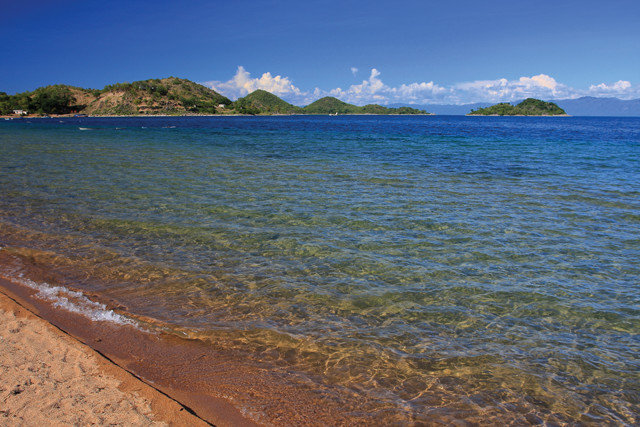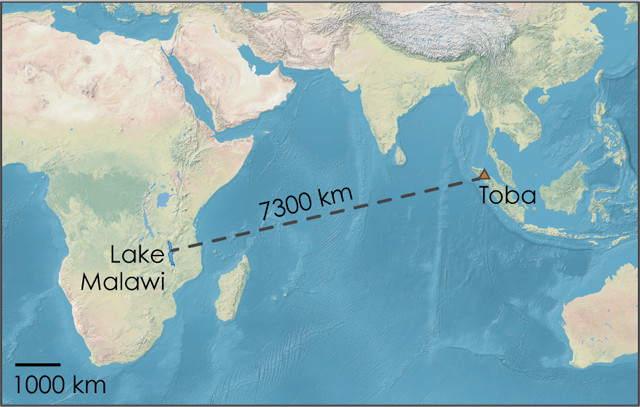
by Timothy Oleson Monday, December 14, 2015

Lake-floor sediments from Lake Malawi in East Africa appear to show no sign of a widespread volcanic winter following the Toba super-eruption 74,000 years ago, according to a new study. Credit: Traveling Otter, CC BY-SA 2.0.
Roughly 74,000 years ago, the largest volcanic eruption of at least the last 2.5 million years — and possibly the last 27 million years — spewed as much as 5,000 cubic kilometers of magma and ash, the latter of which spread far and wide from the source. This catastrophic eruption of the Toba supervolcano on the Indonesian island of Sumatra has long been suggested as a trigger for a precipitous period of global cooling known as a “volcanic winter” that in turn might have driven early humans to the brink of extinction. In a new study, researchers dispute these notions, concluding from an analysis of climate-sensitive microfossils preserved in lake sediments in East Africa — the ancestral home of early humans — that the region experienced little or no cooling following the massive eruption.
Historically, much smaller outbursts — such as the 1815 Tambora eruption, which ejected 160 cubic kilometers of magma and ash (enough to crown it the largest in recorded times), and the 1991 Mount Pinatubo eruption, which ejected just 5 cubic kilometers of material — have caused the planet to cool slightly for several-year stretches. Such cooling results mostly from sulfur-containing aerosol particles being emitted into the stratosphere, where they reflect sunlight until they eventually fall back to Earth’s surface. Past studies have estimated that a post-Toba volcanic winter could have lasted anywhere from several years to several hundred years and cooled the planet by as much as 15 degrees Celsius.
But widely varying estimates of the eruption’s aerosol output and climatic effects, along with uncertainty due to the relatively low resolution of climate records from the time and seemingly contradictory archaeological evidence, have fueled skepticism and debate over whether the Toba super-eruption caused substantial cooling and genetic “bottlenecks” in early human populations.
In the new study, researchers turned to a pair of sediment cores from Lake Malawi, located in East Africa 7,300 kilometers west of the Toba caldera. The cores preserve evidence of the eruption in the form of a thin layer of sediment — buried almost 30 meters below the lake bottom — that contains glassy volcanic ash particles geochemically linked to Toba. Taking samples every few millimeters from the cores, the team cataloged how assemblages of different types of plankton, algae, fly larvae and other microfossils changed in the sediments on a roughly decadal basis from about 50 years before the eruption to 220 years afterward.
Lake Malawi is stratified based on temperature and is meromictic, meaning the different layers of water don’t typically mix with each other, says Lily Jackson, a doctoral student in geosciences at the University of Texas at Austin, and lead author of the study, published in Geology. While warm surface waters maintain this stratification, cooling at the surface has been found to increase mixing between surface and deeper waters in meromictic lakes, thus redistributing heat and nutrients and shifting the landscape of organisms that are best adapted for such conditions.

A volcanic ash layer from the Toba super-eruption roughly 74,000 years ago is preserved in Lake Malawi, which is about 7,300 kilometers west of the volcanic caldera. Credit: K. Cantner, AGI.
If the temperature had dropped by even just a few degrees at the lake’s surface following the Toba eruption, it would have disrupted the thermal stratification of the lake and would have caused mixing, Jackson says. “And that mixing is what we would see in variations in the microfossil indicators.” For instance, she and her colleagues noted, ratios among certain lake-surface dwelling plankton, some of which cope better than others with fewer nutrients, should change as lake mixing shuttles additional nutrients from deeper water toward the surface.
Instead of the dramatic shifts among lake organisms expected to accompany a volcanic winter, however, the researchers reported only minor changes in the lake’s ecology in the decades following the Toba eruption — changes that were “well within ranges observed elsewhere in the [sediment] cores.” Thus, they concluded, if the eruption did cool the air around Lake Malawi, it wasn’t substantial enough to impact the lake. The results are consistent, Jackson says, with those of a 2013 study by other researchers who found little change in sediment compositions and paleotemperature indicators within or above the eruption marker layer in the same cores.
“The Lake Malawi sequence is absolutely critical in understanding what ecological impacts there were” from the Toba eruption, says Michael Petraglia, an archaeologist at the University of Oxford in England who was not involved in the study. These sediments offer “high-resolution environmental information” that hasn’t been available from other study sites, he says. This study “beautifully shows” that the eruption didn’t contribute substantially to global cooling, Petraglia adds, and, when combined with archaeological signs suggesting that humans or human relatives lived through the eruption in places like India, it suggests that the eruption did not have major impacts on humans.
Not everyone agrees, however, that the cores offer such a definitive picture. For one thing, says Stanley Ambrose, an anthropologist at the University of Illinois at Urbana-Champaign, a large deep lake like Malawi has a certain amount of thermal inertia — meaning it might respond sluggishly to changing air temperatures — that could make it insensitive to ephemeral cooling.
And even if this inertia were overcome, he says, the climate proxies studied in both the 2013 study and the new study probably still aren’t sensitive enough to capture a potentially severe but short-lived volcanic winter. Considering it took about 27 years for one centimeter of lake sediment to accumulate based on estimated deposition rates for the time, Ambrose says, the roughly 2-centimeter-thick section of the cores in which Toba ash is observed represents about 55 years of time. This implies that the ash layer, which would initially have been deposited during and shortly after the eruption, might subsequently have been diluted due to sediment mixing at the lake floor, he says. Thus, “even if you had a really strong [cooling] signal” recorded by the climate proxies due to, for example, a six-year volcanic winter, it too would have been heavily diluted, potentially to the point of being unnoticeable in the records presented in the two studies.
Jackson says it is possible that brief and relatively weak cooling, of less than about 4 degrees Celsius, on land might not have caused sufficient mixing in Lake Malawi to register in the microfossil records. But she and her colleagues wrote that a cooling event big enough to disrupt life on land would have also chilled the lake substantially, and that even if a cooling event’s signal were diluted in the sediment column, it would have still shown up as consistent perturbations in the various proxies in their analysis. That such perturbations weren’t seen, she says, gives the impression that the Toba eruption didn’t have “that dramatic of an effect.”
© 2008-2021. All rights reserved. Any copying, redistribution or retransmission of any of the contents of this service without the expressed written permission of the American Geosciences Institute is expressly prohibited. Click here for all copyright requests.